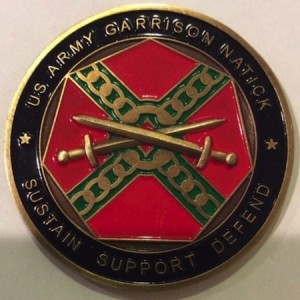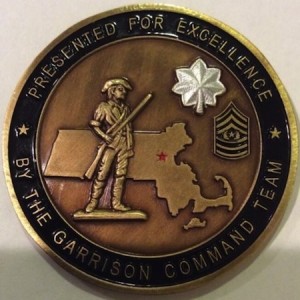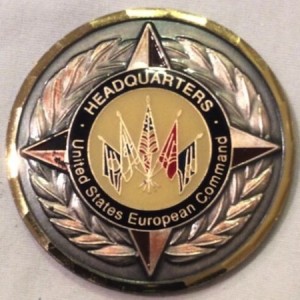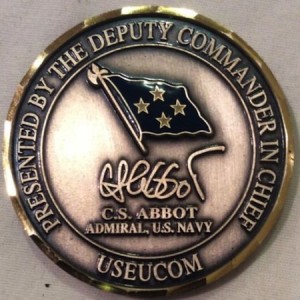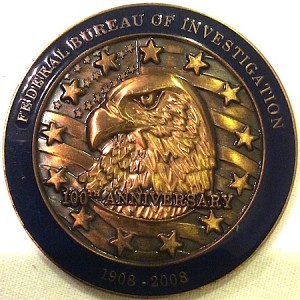Dec 9, 2014 | coin design, coins, commemorative, medals
I know it has been a while since I wrote a substantive post. But as the holiday season is upon us, business has picked up and I am doing a lot of buying and selling. While good for business, it has not provided me time to write. I have a backlog that I will get to, so please be patient.
Of the items I am buying and selling are Challenge Coins. While not coins in the strictest sense of the term challenge coins are the size of large dollar coins or crowns issued, usually issued by a military organization and given to someone as a sign of appreciation. Back in 2009, I wrote about NBC news anchor Brian Williams admitting that he collected challenge coins.
Although given in appreciation, not everyone appreciates their significance and, in some cases, their beauty. Aside from finding them in estate sales, they are included in large lots of items I purchase while looking for other items. For some reason, the sellers throw them into the lot thinking that they are not worth much.
For the most part, challenge coins do not have value the way coins have value. Most challenge coins are enameled bronze disks. What makes them interesting is the topic, the location depicted, or who issued the coin. Some challenge coins are very basic while others have artistic value that rivals anything issued by government mints.
Although I have handled hundreds of challenge coins in the last year, two stand out as exception. Unfortunately, I was so excited to have found them that I sold them to new owners before taking pictures. One was a coin that was overlaid on a large “V” which was to be the Roman numeral for five. It was very striking. The other was a coin that was three-inches wide by one-inch tall in the shape of a dog bone. This very unique challenge coin was issued for an anniversary of the police canine unit of Amtrak in Chicago. Aside from various insignias and images of the five types of dogs that Amtrak Police Canine Unit trains, the coin included representative flags including one for the City of Chicago.
Here are some challenge coins that I have recently sold:
U.S. Army Garrison Natick Challenge Coin
Presented for Excellence by the Garrison Command Team in Natick, Mass.
U.S. European Command (USEUCOM) Headquarters Challenge Coin
Presented by the Deputy Command in Chief C.S. Abbot, Admiral, U.S. Navy
Rear Admiral Charles S. Abbot (ret.) was Deputy Commander in Chief of USEUCOM from 1998 to 2000.
78th Troop Command Challenge Coin
“Georgia’s 911 Force”
The 78th Troop Command is the Georgia National Guard. Coins was presented by the Sargent Major (see the insignia on the reverse).
United States Forces Korea Challenge Coin
50th Anniversary of the Korean War Commemoration
Federal Bureau of Investigation Challenge Coin
100th Anniversary of the FBI
Finally, if you want to start your own challenge coins collection, here are a few I have for sale for you to start:
Oct 31, 2014 | ANA, CCAC, coin design, coins, commemorative, commentary, gold, halves, medals, policy, silver, US Mint
 It has been a few years since I did an All-Hallows-Eve numismatic trick-or-treat that it seems like a good time to do add one. Here are my numismatic tricks and treats for this past year.
It has been a few years since I did an All-Hallows-Eve numismatic trick-or-treat that it seems like a good time to do add one. Here are my numismatic tricks and treats for this past year.
Girl Scouts need a values adustment
TRICK: It was announced in January that the 2013 Girl Scouts commemorative coin did not generate enough sales for the U.S. Mint to provide a payout of seignorage. This is the first time this has happened. Part of the problem was that the Girl Scouts are stuck in the 1950s mindset that does not see collecting coins as a girl’s hobby. Although values are important, this shows that he Girl Scouts’ values are behind the times and will not be the catalyst behind helping expand the hobby. They should be ashamed for contributing to this failure.
ANA Willfully Gives up its Premier Status
TRICK:The Professional Numismatists Guild and the American Numismatic Association announced in January that “the first” PNG-ANA Numismatic Trade Show the weekend prior to the 2014 World’s Fair of Money in Rosemont that it will be open to the public. While making it sound exciting it made the entire show 8-days long. This was a bad move because of the length and because it makes the ANA play second to PNG. If the ANA wants to be the premier numismatic organization, the one that anyone wanting to learn about and be about numismatics, The ANA should not play second fiddle to any other organization.
There are coin treats!
TREAT:In creating a tribute to the 50th anniversary of the Kenney half-dollar, the U.S. Mint has made a coin that is not really circulated into something interesting for the collector. The dual-dated gold coin became an instant hit before the price of gold dropped and the silver sets are reportedly selling well. This was a good move by the U.S. Mint.
TREAT:For the most part, commemorative coins are sales do not meet expectation. While there are a few exceptions like 2005 Marine Corps 230th Anniversary silver dollar, most commemoratives do not come close to their maximum mintage. But the 2014 National Baseball Hall of Fame commemoratives appear to have hit a home run. The combination of the subject and the curve of the coin may be a significant factor in the coin’s success. The $5 gold and silver dollar coins are both sold out. There are some of the clad half-dollars available.
TREAT:Speaking of cool stories, what about the Saddle Ridge Hoard? After a couple found the hoard of gold coins while walking their dog, it spawned an interest in metal detectors and searching for buried treasure. It was such an amazing story that it even found its way into the national news cycle. But like everything else, another shiny story diverted the media’s attention and the coins went on sale to the general public on Amazon.com.
Not all coins are treats
TRICK: Colored and coins with gimmicks are proliferating in the market. So far, the U.S. Mint and the Royal Mint are resisting colored and other gimmicks while the Royal Candian Mint and New Zealand Mint are at a race to the bottom for gimmick coins.
Numsimatics and technology
TREAT: The ANA launched its new website with new technology ready for growth on time and under budget. This is the website that ANA Governor Laura Sperber said, “I can’t wait to see what a disaster the ANA new web site will be.” So far, there has not been a follow up from Sperber while the new site has been a success.
TREAT: More recently, the U.S. Mint had a great launch to their new website. After years of frustration with the online ordering of what would be popular items, the new site handled the launch of the 50th Anniversary Kennedy 2014 Half-Dollar Silver Coin Collection with no issues.
Failure to launch
TRICK: The U.S. Mint launched the Baseball Hall of Fame commemorative coin at the Whitman Show in March not anticipating its popularity with fewer coins that there was a demand. It was as if the U.S. Mint had a blind spot with how popular this coin would be.
TRICK: The dealers who paid less than desireable people uninterested in anything other than a quick buck to mob the lines at the Denver Mint and the World’s Fair of Money. I continue to belive that their ethics must be questioned and appropriate actions taken by the ANA even though I do not think that will happen.
TREAT: With the drop in the price of gold, the current price of the gold Kennedy half-dollar tribute is less than what is was at launch. Teach these greedy dealers a lesson and buy the coins for less directly from the U.S. Mint!
U.S. Government hands out coal
TRICK: Because the U.S. Mint can only do what the laws that congress pass tells them they can do and congress is so dysfunctional they cannot even pass laws for issues they agree on, the United States was the only country involved with the Allies on D-Day NOT to issued a commemorative to honor the 70th anniversary of D-Day.
TRICK: In the name of political correctness, the State Department’s Cultural Property Advisory Committee (CPAC) continues to make it difficult for ancient coin collectors to participate in its hobby by allowing countries to ask the State Department to overreach on the enforcement on the Cultural Property Implementation Act. It is turning ancient coin collectors into criminals even for collecting common coins. Their actions are rediculous.
CCAC is the CCAC
TREAT: The Citizens Coinage Advisory Committee suggested creating American Arts medals that will feature the artistic ability of the U.S. Mint’s artist.
TRICK: The arts medals are medals, not coins. Even with the beauty of medals like the 9/11 silver medal, it did not sell like coins would. In fact, it grossly under performed without raising significant sums for the 9/11 Memorial at the site of the Twin Towers in New York. But this is what the CCAC is face with because of congressional dysfunction (see above).
So goodbye everybody, and remember the terrible lesson you learned tonight. That grinning, glowing, globular invader of your living room is an inhabitant of the pumpkin patch, and if your doorbell rings and nobody’s there, that was no Martian… it’s Hallowe’en.
— Orson Welles, The War of the Worlds, CBS Radio, October 30, 1938

Hobo Ike and Jefferson courtesy of Darth Morgan posted at
Coin CommunityAug 26, 2014 | coin design, coins, commemorative, foreign, web
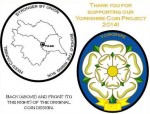
Proposed design of the Yorkshire (UK) Challenge Coin.
Think about how you would feel to help a community create a challenge coin for itself. In the process of helping the community, you can collect one of these challenge coins for yourself. If you provide enough assistance, then you can own one of the lowest numbered challenge coin.
Buried in my inbox was a note about a KickStarter project to create a challenge coin for Yorkshire, U.K. For as little as £6, (currently $9.94) you can own a coin numbered between 100 and 999. If you can afford £20 ($33.14), you can own a coin numbered between 10 and 20. Sorry, but the lower numbers have been purchased. All you have to do is go to KickStarter and fund the project.
For those not familiar with KickStarter, it is a website used to allow interested people to fund projects of their choosing. Kickstarter projects are mostly creative endeavors or involve some creativity in art, music, and technology where you receive awards for your level of funding. The financing model is called “crowd sourcing” and has been used effectively to launch films for the Sundance Film Festival, a skate park in Philadelphia, a photo exhibit on the site of the Berlin Wall, and the Fitbit smart watch.
KickStarter uses and all or nothing model meaning that if the project only receives the money if it is fully funded. If it does not, your credit card will not be charged and you will not receive your premium, of course. For the Yorkshire challenge coin, they are asking for £3,000 ($4,970.52). Currently, there is £220 pledged ($364.50) with 3 days to go. The funding drive ends on Saturday, August 30 at 1:36 AM EDT.
What the heck… it seems like a very cool idea. Let’s see if we can help put the project over the top and get it funded. Even if you do not want the coin, you can spare £3 (about $5) to help!
Note that there are extra postage requirements for shipping outside of the United Kingdom.
Jul 21, 2014 | CCAC, coin design, coins, gold, medals, Peace, silver

2009 Ultra High Relief Double Eagle Gold Coin
“Discussion of a potential 2015 24K Gold Ultra-High Relief Coin and accompanying silver medal.”
In 2008, it became then Mint Director Edmund Moy’s “pet project” to create the ultra-high relief Augustus Saint-Gaudens double eagle design in a manner that Saint-Gaudens originally envisioned. The result was the 2009 Ultra High Relief Gold Coin. The design was based on the plaster casts originally made by Saint-Gaudens that was digitized and the equipment purchased that would be able to strike the coin.
Moy is no longer Director but the U.S. Mint still has the equipment used to strike the coin. The question is what does the U.S. Mint have in mind for creating a high-relief coin?
Also, what do they have in mind for an accompanying silver medal and how do they justify creating a medal? While the U.S. Mint can use the same law that authorizes the 24-Karat Gold Buffalo coin (31 U.S.C. § 5112(q)), it is uncertain what can be leverage for the silver medal. It is possible that the U.S. Mint might be leveraging 31 U.S.C. § 5111(a)(2) that says The Secretary of the Treasury “may prepare national medal dies and strike national and other medals if it does not interfere with regular minting operations but may not prepare private medal dies.” Before we pass further judgement we will wait to hear what the U.S. Mint says.
As for the subject, since they Saint-Gaudens double eagle design as been used, what other high-relief design has issues? The only design that comes to mind is the Anthony de Francisci Peace dollar. But not just the Peace dollar, but the original design with the broken sword.
The broken sword was not well received. According to numismatic researcher Roger Burdette, he discovered a editorial that appeared in the New York Herald that summarized the feeling about the broken sword:
A sword is broken when its owner has disgraced himself. It is broken when a battle is lost and breaking is the alternative to surrendering. A sword is broken when the man who wears it can no longer render allegiance to his sovereign. But America has not broken its sword. It has not been cashiered or beaten; it has not lost allegiance to itself. The blade is bright and keen and wholly dependable. It is regrettable that the artist should have made such an error in symbolism. The sword is emblematic of Justice as well as of Strength. Let not the world be deceived by this new dollar. The American effort to limit armament and to prevent war or at least reduce its horror does not mean that our sword is broken.
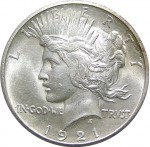
1921-D Peace Dollar
Although struck in Denver in late December 1921, the 1921-D Peace dollar was released into circulation on January 3, 1922.
Later that year it was determined that the high-relief design was causing dies to break at a faster pace than planned. The Mint then lowered the relief in order to keep striking coins at the rate required by law. This became the second type of the Peace dollar series.
Because 2015 will be 95 years since the first Peace dollar, I suspect that the high-relief gold coin will be a 2015 tribute to that first Peace dollar.

Artist’s conception of a 1964-D Peace dollar.
The striking of a dollar coin had a powerful ally: Senator Majority Leader Mike Mansfield, Democrat from Montana, whose state would be directly affected by the new coins. Although the numismatic press was not in favor of the measure because of its limited ability to solve the coin shortage, Mansfield pushed a bill through congress to authorize the Mint to strike 45 million silver dollars.
After much discussion, the Mint looked for working dies but found that few survived a 1937 destruction order. Those that did survive were in poor condition. Mint Assistant Engraver Frank Gasparro, who would later become the Mint’s 10th Chief Engraver, was authorized to create new dies of the Peace dollar with the “D” mintmark. Since the coins would mostly circulate in the west it was logical to strike them closest to the area of interest.
When the coins were announced, coin dealers immediately offered $7.50 per coin which would ensure that they would not circulate as intended. Everyone saw this as a poor use of Mint resources during a time of severe coin shortages. Adams announced that the pieces were trial strikes never intended for circulation and were later melted under reportedly heavy security.
There have been reports that some Peace dollars were struck using base metals (copper-nickel clad) as experimental pieces in 1970 in anticipation of the approval of the Eisenhower dollar. The same reports also presume these coins have been destroyed.
While we are speculating, the companion silver medal could be a modern tribute to the 1964-D Peace dollar by minting a 1915-D silver medal with the same design but without a denomination. It would be the same design but with out “ONE DOLLAR” struck on the reverse.
A high-relief 24-karat gold Peace dollar design and a silver version without the denomination. That’s my prediction, what’s yours?
2009 Ultra-High Relief image courtesy of the U.S. Mint
1921-D Peace dollar courtesy of the author.
Artists conception of the 1964-D Peace dollar courtesy of PCGS.
Jun 21, 2014 | coin design, coins, commemorative, commentary, gold, policy, US Mint
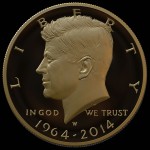
U.S. Mint mock-up of the 24 karat gold 50th anniversary Kennedy half dollar
It has been an ongoing theme written on this blog, the latest was about the nonsensical $1 Trillion coin, is that all you have to do to understand what the U.S. Mint can and cannot do is clearly documented in Title 31, Section 5112 of the United States Code (31 U.S.C. § 5112), Denominations, specifications, and design of coins.
You can read Section 5112 without having to obtain a law degree. It is very readable. It is the section that covers all of the specification for every coin struck by the Mint. It describes the size, weight, content, and the design of the coin. Very little is left up to the Mint in coinage design. But as the U.S. Mint is run by fallible humans, these laws were written by even more fallible humans: congress. This means that some of the laws are very clear while others are open to some interpretation.
First, it has been questioned whether the U.S. Mint can strike more 2014 National Baseball Hall of Fame commemorative coins since they sold out of the gold and silver coins. The answer to that question can be found in law (31 U.S.C. § 5112(m)). This is the section that describes the legal requirements for commemorative coins. Paragraph (2)(B) (31 U.S.C. § 5112(m)(2)(B)) says (emphasis mine):
If the Secretary determines, based on independent, market-based research conducted by a designated recipient organization of a commemorative coin program, that the mintage levels described in subparagraph (A) are not adequate to meet public demand for that commemorative coin, the Secretary may waive one or more of the requirements of subparagraph (A) with respect to that commemorative coin program.
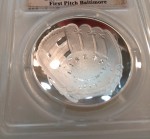
2014 National Baseball Hall of Fame commemorative silver dollars and gold commemoratives are sold out at the U.S. Mint.
As was the case with the 2005 Marine Corps Commemorative Silver Dollar, a quick sellout of the coins does satisfy the evidence necessary for the Secretary to make the decision to increase the production limits. In 2005, then Secretary of the Treasury John W. Snow authorized the U.S. Mint to produce 100,000 additional silver dollars. This was the last commemorative program sellout prior to the Hall of Fame coins.
However, the proposal to increase the production of the National Baseball Hall of Fame coins is speculation. This rumor has not been acknowledged by the U.S. Mint or the Department of the Treasury.
The other claim is that it is illegal or questionable that the U.S. Mint can produce the 2014 Kennedy Half Dollar gold coin. In an op-ed printed in Coin World, William T. Gibbs wrote, “The Mint is using what it cites as existing authority to produce a .9999 fine gold half dollar struck at the West Point Mint, with a 1964–2014 dual date and the higher relief 1964 portrait. The logic behind this coin is hard to understand. We’ve never had a gold half dollar before and the Mint’s legal authority to issue it is open to debate.”
Equating the fact that the U.S. Mint has never produced a gold half dollar coin is a parochial discussion and not whether the U.S. Mint can legally produce the coin. After all, the U.S. Mint produces quarter dollars made of five ounces of silver.

Congress makes the laws and they can change at almost any time!
The same questions were raised when the U.S. Mint issued the 2009 Ultra High Relief Double Eagle Gold Coin. The coin was based on the 1907 design by Augustus Saint-Gaudens was produced in .9999 fine gold and was issued under the Gold Bullion Coins provision of the law (31 U.S.C. § 5112(q)).
Gibbs further says, “When the Mint struck gold versions of the 2000 Sacagawea dollar and announced plans to sell them to the public, Congress stopped the Mint, stating that Mint officials lacked constitutional authority to issue the dollar coin in gold” as an additional argument against the U.S. Mint producing the Kennedy gold coin. In 2000, the law authorizing the U.S. Mint to strike 24-karat coins did not exit. The Buffalo Gold Bullion coin program that the decision is based was signed into law on December 22, 2005 as part of the Presidential $1 Coin Act of 2005 (Public Law 109–145 [PDF]).
The U.S. Mint may not be the most perfect agency and you may not like their decisions, but to accuse them of questionable legal practices is a bit naive.
Jun 16, 2014 | coin design, coins, nclt, silver

Anders Celsius
Celsius was a Swedish physicist, mathematician and a professor of astronomy at Uppsala University. As one of Sweden’s premier scientists of his day, Celsius traveled extensively to research ways to measure degrees from the poles in order to improve mapping and navigation. He believed that by studying the stars we could learn more about the composition of the earth and its origins, something we are still doing today.
The research he is most known for was as the first scientist to experiment with temperature in order to define a definitive scale to be used by all scientists as the basis for their experiments. In 1742, Celsius published the paper Observations of two persistent degrees on a thermometer where he defined 100 as the freezing point of water and 0 as its boiling point with a scale of units in between. He called his scale “centigrade” derived from the Latin for “hundred steps.”
Independently, physicist Jean-Pierre Christin of France developed a similar scale with 0 as the freezing point of water and 100 as its boiling point. In 1743, Christin commissioned the building of the “Thermometer of Lyon,” a mercury thermometer based on his research.
Celsius died in 1744 at the age of 42 from tuberculosis. A year after his death, colleague Carolus Linneaus, a botanist interested in the effects of temperature on growing plants, reversed Celsius’ scale and improved on the design for the thermometer. In a paper published in 1745, Linneaus first used the Celsius to describe the temperature scale. He later convinced the Royal Swedish Academy of Sciences to change the name of the scale to Celsius in memory of his late colleague.
To honor Celsius, the Cook Islands hired Coin Invest Trust of Balzers, Liechtenstein to design and strike a coin to honor Andres Celsius. The coin with a 5 Dollar face value will 50mm in diameter and proof struck using one troy ounce of .925 silver. Mintage will be limited to 1744 pieces.
The coin’s unique reverse design will include a thermometer that will be integrated around the center of the coin that will feature the portrait of Anders Celsius. Based on the images, the thermometer looks like it will be based on the same technology as those used in temperature strips. The area where the portrait will be features a little degree mark before the C in Celsius, the date 1744-2014, and a small depiction of a thermometer.
Since Cook Islands are under the sovereignty of New Zealand and New Zealand is a member of the Commonwealth Realm, Queen Elizabeth II is the legal head of state and appears on the obverse of the coin. The portrait is by British sculptor Ian Rank-Broadley whose work appears on all coins of the Commonwealth Realm.
-
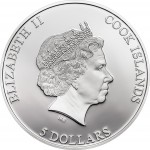
-
Obverse of the 2014 Cook Island Anders Celsius NCLT features the Ian Rank-Broadley image of Queen Elizabeth II.
-
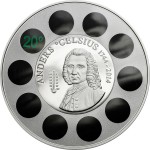
-
Reverse of the 2014 Cook Island Anders Celsius NCLT features a portrait of Celsius surrounded by a working thermometer.
No announcement has been made as to when it will be available and the purchase price.
Given my resistance to gimmicks on coins (with my own admitted hypocrisy), there is still something compelling about the proposed design for this non-circulating legal tender (NCLT) coin. I will wait to see how much the coin will cost before making a commitment one way or the other.
-

-
An image of how the 2014 Cook Island Anders Celsius NCLT coin presentation case.
-

-
An image of how the 2014 Cook Island Anders Celsius NCLT coin will look in its presentation case.
-
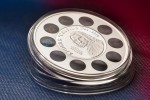
-
An image of how the 2014 Cook Island Anders Celsius NCLT coin will look in its holder.
Image of Anders Celsius from Wikimedia Commons
Coin images courtesy of Coin Invest Trust
May 15, 2014 | coin design, coins, national park quarters
Too many serious topics lately. Let’s have a little numismatic fun.
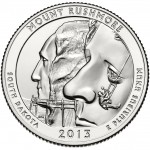 It was a busy day. While I really wanted to go out for lunch, all I had time for was to go to the cafeteria in the building where I work to get something quick. After settling on something I went to pay handing the cashier a piece of paper with the portrait of Andrew Jackson. In the change returned were three quarters. Most of the time I will just drop the change in my pocket and check it out later. But on this day, I took a glance at the coins and something struck me. Well, it didn’t strike me but it looks like something struck one of my quarter. Twice!
It was a busy day. While I really wanted to go out for lunch, all I had time for was to go to the cafeteria in the building where I work to get something quick. After settling on something I went to pay handing the cashier a piece of paper with the portrait of Andrew Jackson. In the change returned were three quarters. Most of the time I will just drop the change in my pocket and check it out later. But on this day, I took a glance at the coins and something struck me. Well, it didn’t strike me but it looks like something struck one of my quarter. Twice!
Closing my hands around the coins I walked away from the cash register and found a place I could stop to better examine what I had. Did I just find a rare double-strike quarter? Is it really an error? How much could it be worth?
Putting down my lunch container, I opened my hand and found quarters. Not just one but three quarters. Three 2013 Mount Rushmore quarters. It was not a double-strike but the double-image of the side-by-side portraits that fooled me.
And this happened more than once. If I take a quick glance at change that contains the Mount Rushmore quarters I get the impression that I found a double-struck coin.
The Mount Rushmore quarter has to be one of the better designs of the America the Beautiful Quarters® Program. Rather than attempting to be a pretty postcard-like image of the place of honor, the design is more about the sculpting of the impressive monument.
So be careful when glancing at your change. Those two faces side-by-side is not a double-strike or double-die. It is just a portrait of a portrait of George and Thomas being immortalized in granite.
Feb 13, 2014 | Australia, coin design, coins, commentary, nclt
Whenever I comment on using design elements on coins that do not involve engraving I am reminded that one person’s gimmick is another’s innovation. I am also reminded that I have demonstrated a bit of hypocrisy by purchasing some of these coins for my collection including celebrating the innovation of one of these coins. So why do I have a near visceral reaction to the introduction of a coin whose purpose is to commemorate with a non-engraved design elements?
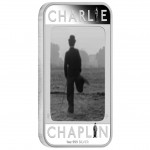
2014 Charlie Chaplin 1 oz lenticular commemorative coin from the Perth Mint
The reverse does not use just any image. It is the iconic image of the waddling tramp walking away from the camera. Like the image on the screen, this is a moving image. Using lenticular technology, the image will shift as you move the coin making it appear that Chaplin is walking.
Chaplin was the nascent movie industry’s first megastar. Although Mary Pickford and Douglas Fairbanks were the most recognizable of the time, Chaplin was the first actor whose movies were considered a success because he was involved with them. And while there were posters and booklets printed about other stars, Chaplin was the first to be fully merchandised around the world including a Chaplin doll that is one of the most prized toy and movie memorabilia collectibles today.
Even though Chaplin was the phenomenon of this time and I consider myself a fan, I am having a difficult time liking this coin.
In fact, I downright hate it!
I cannot explain why I hate this coin because I am interested in the Niue 2007 Van Gogh silver coin and the Andorra 2008 Renoir 10 Diners silver coin. All three coins are colored coins and ingot shaped, but the Chaplin coin really bothers me.
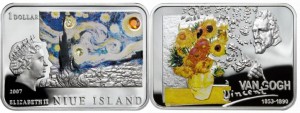
Niue Island 2007 Great Painters – Vincent Van Gogh $1 Rectangular Silver Dollar with Color and Zircon Crystal Gemstones
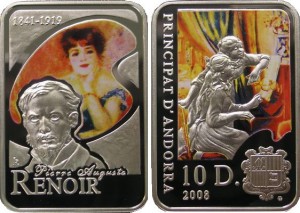
Andorra 2008 Great Painters – Pierre August Renoir 10 Diners Rectangular Silver Proof with Color
Although I did not like the Monnaie de Paris 2012 Yves Klein commemorative coin with the blue hand, I did not have this type of reaction. However, I still like the 2006 Canadian Breast Cancer commemorative and circulating quarter with enameled features.
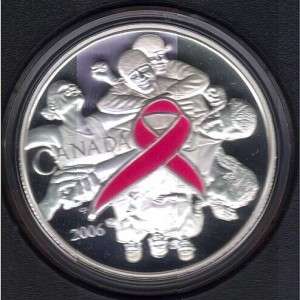
2006 Breast Cancer Silver Coin with colored pink ribbon.

2006 Breast Cancer Quarter was Canada’s first colored circulating coin
One of the differences between the colored coins that I like versus those that I do not are the ones I like do have some engraving involved. And even though I do not like the Yves Klein commemorative, I do not find it as objectionable because the blue hand is an enhancement and not the entire design on the coin.
Not counting the Somalia motorcycle and sports car coins, I seem to have this response where the coloring or design gimmick encompasses the entire design of the coin. Once the coloring or other design elements that are not engraved go beyond enhancements and are used to create the design is when I begin to object.

2007 Somalia Motorcycle Non-circulating Legal Tender Coins

2010 Somalia Sports Cars
It could also be the subject matter. As a resurgent gear-head with an eye toward the classics, the Somalia classic motorcycles and sports car coins appeal to me while the coins with colored birds and flowers do not. As the surviving spouse of a cancer victim, I supported the use of coins to raise money for cancer research by the Royal Canadian Mint, but none of the current hologram coins would interest me if they did not have the holograms.
Color and other enhancements on coins are here to stay. If there were not a market for them then the various mints would not produce these types of coins. It may be something that will attract more collectors and grow the hobby, which is good.
Maybe I should think about these enhancements like I think about cars: I want a car that drives and feels like a car and a coin that is engraved art; I do not want to drive a computer nor a coin that seems gimmicky.
Credits
- Image of the 2014 Charlie Chaplin 1-ounce lenticular silver coin courtesy of the Perth Mint.
- Images of the Van Gogh and Renoir coins courtesy of Talisman Coins.
Jan 3, 2014 | coin design, coins, commemorative, commentary, COTY
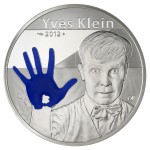
Monnaie de Paris 2012 Yves Klein commemorative was named 2014 Coin of the Year

2011 Commemorative celebrating the 100th anniversary of the Royal Dutch Mint’s facilities with QR code on reverse

2010 Jonah In The Whale 2-New Sheqalim coin from Israel

2009 White Rhinoceros 100 Rand gold coin from South Africa
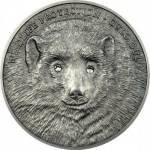
2008 Mongolia Wolverine with diamonds for eyes
Three of the last five COTY winners had design elements that were not based on the sculpture of the coin but on a design gimmick. Were these the best designs or did the gimmick influence the voting?
I have asked before whether it is wrong to include other design elements on a coin, especially non-circulating legal tender (NCLT) coins. When I ask these questions, I bring out the picture of my Somalia motorcycle or muscle car coins. I also like the Canadian 2006 Breast Cancer silver commemorative coin and the special 25-cent circulating coin the Royal Canadian Mint produced. These were not overt uses of color but almost an enhancement to emphasize the pink ribbons on the coins.
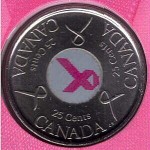
2006 Breast Cancer Quarter was Canada’s first colored circulating coin
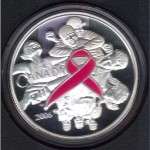
2006 Breast Cancer Silver Coin with colored pink ribbon.
But is it too much of a gimmick? After the RCM produced those coins it seems that they dove in face first into producing colored coins. It also seems that the rest of the world also has been spending its time printing coins and not minting them (see the New Zealand Mint). Although I am guilty of buying into this type of design concept, there comes a time when the concept has gone too far. In television the concept is called “Jumping the Shark.”
While others are printing coins, the Royal Mint is coming up with designs that are interesting sculptures. In fact, if you go to their website and look at their offerings you will find that the Royal Mint has nice designs, interesting packaging, but no color. Although their artists take advantage of the design elements using bi-metallic coins, they are sculptured arts and not printed designs.
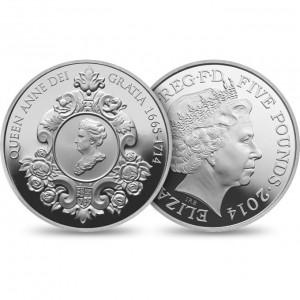
2014 £5 crown commemorating the 300th anniversary of the death of Queen Anne
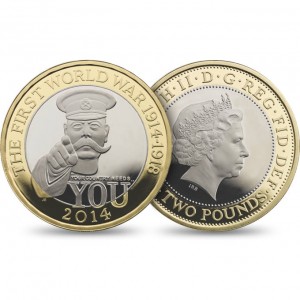
2014 £2 coin commemorating the 100 year anniversary of the start of World War I
U.S. coin designs have had the best designs over the last few years. However, the introduction of the “enhanced uncirculated” coins with the selective frosting has opened up new ways of enhancing sculpture elements on coins. It would be interesting to see what the U.S. Mint artists can do if given the free hand to design coins and using the laser to enhance the design.
Given the recent history of the COTY competition, the 2014 National Baseball Hall of Fame commemorative coin is almost a shoo-in for 2016 COTY honors. While the elements will be sculpted rather than printed and the curved planchet will be interesting, it is probably enough of a gimmick to sway the World Coin News confab when it meets to discuss the 2014 coin in December 2015.
As an aside, why do we have to wait a year for the COTY competition? With technology what it is today, why does it take a year to do the COTY competition? If the award is given in February, then why select the COTY in December or January? Does it really make sense for the 2014 COTY to be coins date 2012? Why not call it the 2012 COTY since the coins are dated 2012 and award them at the beginning of 2013—or in this case, the 2013 COTY being awarded in 2014?
The one year delay might have made sense when mail delivery was less reliable and information was delayed by the speed of the teletype and the printing press. In the information age where 2012 is not only yesterday’s news it is ancient history, it is time for Krause Publications and World Coin News to modernize their process and come up with something a little quicker than a one year delay.
Image Credits
- 2012 Yves Klein commemorative courtesy of the Monnaie de Paris.
- 2011 Royal Dutch Mint commemorative with QR code courtesy of the Royal Dutch Mint.
- 2010 Jonah in the Whale commemorative courtesy of the Israel Coins & Medals Corp.
- 2009 White Rhinoceros 100 Rand gold coin courtesy of Krause Publications.
- 2008 Mongolia Wolverine coin courtesy of the Wolverine Foundation.
- 2014 British coin images courtesy of the Royal Mint.
Dec 31, 2013 | coin design, coins, commemorative, US Mint
For the first time ever, the U.S. Mint will be producing a coin that is not flat. The curved coin is of the 2014 National Baseball Hall of Fame Commemorative Coin.
The National Baseball Hall of Fame Commemorative Coin Act (Public Law 112-152 [PDF]) celebrates the 75th Anniversary of the National Baseball Hall of Fame in Cooperstown, New York. The three-coin commemorative program consisting of a $5 gold coin (50,000 maximum mintage), $1 silver coin (400,000 maximum), and a clad half-dollar (750,000 maximum) struck as uncirculated coins or as proofs.
The bill required an open competition for a common obverse design “emblematic of the game of baseball.” During the government shutdown this past October, the U.S. Mint posted the announcement on their website that the winning design was submitted by Cassie McFarland of San Luis Obispo, California.
McFarland told reporters that she stumbled upon the competition while researching coins for another art project. McFarland found the U.S. Mint’s call for design two days before the deadline and submitted a drawing. Her drawing was based on an old baseball glove belonging to a relative.

Cassie McFarland
U.S. Mint Sculptor-Engraver Don Everhart will do the engraving of McFarland’s winning design. Everhart created the reverse design.
Surcharges will be $35 per gold coin, $10 per silver coin, and $5 for the clad half-dollar to be paid to the National Baseball Hall of Fame for their continuing operations. If all the coins sell out, the Hall of Fame will receive $9.5 million for ongoing operations.
Given that the selection of Coin of the Year tends to favor gimmicks (to explained in a future post), it would not be surprising that this coin wins COTY when it is considered at the end of 2015.
In the mean time, it will be interesting to see this coin in hand as this is the #1 numismatic-related story as selected by the board of the Coin Collectors Blog!
Curved coin animation courtesy of the U.S. Mint.
